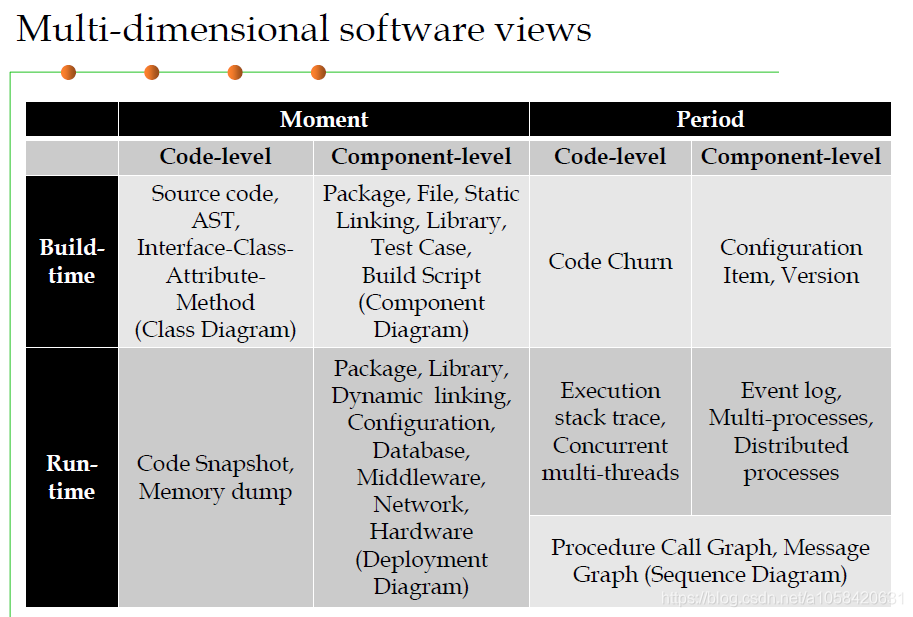| chapter | content |
|---|---|
| 1 | What is a "high-quality software," How to characterize software from different dimensions |
| 2 | The basic structure of software processes and procedures |
| 3 | Theoretical basis --ADT technical basis --OOP software structure |
1.1 software construct multi-dimensional view
1.1.1 The Formation of software systems from three dimensions
- By phases: build- and run- time views by Phasing: When constructed / runtime view
- By dynamics: moment and period views by dynamic allocation: time / stage view
Moment: software form a particular time
Period view: Form Software change over time
- by levels: code and component views hierarchically constructed object division: Code / member view
code: logical organization of functions of code, classes, Methods, the interfaces
component: code physical organization files, directories, packages, libraries

compiled Java language

interpreted languages Perl, Python

1.1.2 The "software construction" as "conversion between different views."

1.2 Quality Index
1.2.1Quality properties of software systems
– External vs. internal quality factors
External factors affecting the quality of the user
factors internal quality of the software itself and its developers
external quality depends on the quality of internal
– Important external quality factors
1.正确性:按照预先定义的“规约”执行
方法:
1.测试和调试:发现不正确、消除不正确
2.防御式编程:在写程序的时候就确保正确性
2.健壮性:针对异常情况的处理
异常处理:所谓的“异常”,取决于spec的范畴
3.可扩展性:对软件的规约进行修改,是否足够容易?应对变化
– Tradeoff between quality factors
1.2.2Five key quality objectives of software construction
– Easy to understand: elegant and beautiful code / understandability
– Ready for change: maintainability and adaptability
– Cheap for develop: design for/with reuse: reusability
– Safe from bugs: robustness
– Efficient to run: performance
3
| 章节 | 内容 |
|---|---|
| 3-1 | “数据类型”及其特性 |
| 3-2 | 方法和操作的“规约”及其特性 |
| 3-3 | 将数据和操作复合起来,构成ADT |
3.1数据类型及检查
3.2设计规约
更强的后置
条件意味着实现的自由度更低了在图中的面积更小
更弱的前置
实现时要处理更多的可能输入,实现的自由度低了,面积更小
3.3抽象数据类型(ADT)
抽象数据类型与表示独立性:如何设计良好的抽象数据结构,通过封
装来避免客户端获取数据的内部表示(即“表示泄露”),在client和implementer之间建立“防火墙”
抽象类型:强调“作用于数据上的操作”,程序员和
client无需关心数据如何具体存储的,只需设计/使用操作即可。

表示独立性:client使用ADT时无需考虑其内部如何实现,ADT内部表示的变化不应影响外部spec和客户端。
不变量:在任何时候总是true,由ADT来负责其不变量,与client端的任何行为无关
保持程序的“正确性”,容易发现错误
假设client有“恶意”破坏ADT的不变量—defensive programming
保持不变性和避免表示泄漏,是ADT最重要的一个Invariant!
表示不变量和抽象函数:

rep的值和客户端看到的值
表示不变性RI:某个具体的“表示”是否是“合法的”
在对象的初始状态不变量为true,在对象发生变化时,不变量也要为true
构造器和生产器在创建对象时要确保不变量为true
变值器和观察器在执行时必须保持不变性。
在每个方法return之前,用checkRep()检查不变量是否得以保持。
抽象函数:R和A之间映射关系的函数,即如何去解释R中的每一个值为A中的每一个值。
一般函数不允许一对多,多对一是允许的
单射:一对一,A中有剩余
满射:所有 “B” 的元素都有至少一个相对的 “A” 的元素
双射:完美一对一

选择某种特定的表示方式R,进而指定某个子集是“合法”的(RI),并为该子集中的每个值做出“解释”(AF)——即如何映射到抽象空间中的值。
checkRep:在所有可能改变rep的方法内都要检查
Observer方法可以不用,但建议也要检查,以防止你的“万一”
beneficent mutation (有益的可变性)
对immutable的ADT来说,它在A空间的abstract value应是不变的。
但其内部表示的R空间中的取值则可以是变化的。
举例:toString输出分数时,进行了约分。
这种mutation只是改变了R值,并未改变A值,对client来说是
immutable的“AF并非单射”,从一个R值变成了另一个R值
作用:通过牺牲immutability的部分原则来换取“效率”和“性能”
– Caching:例如通过cache暂存某些频繁计算的结果
– Data structure rebalancing:例如对tree数据结构进行插入或删除节点之后
– Lazy computation:上例中在toString()的时候才进行约分计算


3.4面向对象的编程
接口提供API,有不同的子类实现

接口:确定ADT规约
类:实现ADT

问题:接口定义中没有包含constructor,也无法保证所有实现类中都包含了同样名字的constructor。故而,客户端需要知道该接口的某个具体实现类的名字
解决:静态工厂

继承和重写:
严格继承:子类只能添加新方法,无法重写超类中的方法,加final关键字无法重写
父类方法可以复用,在父类中写,特殊子类重写
没有可复用的方法,直接留空,每个子类都重写
override关键字和super

扩展父类方法

使用this或者that构造,必须是第一个构造。

抽象类和抽象方法:
子类共有的在父类中实现,子类特有的定义为抽象方法,分别在子类中实现。
多态 Polymorphism
- 特殊多态:函数的功能重载
多个函数有相同的名字,但有不同的参数列表和返回值类型
overload在编译时根据引用类型决定

override在运行时根据对象类型决定

- MUST
不同的参数列表 参数数量或者参数类型 - CAN
相同/不同的返回值类型
相同/不同的public/private/protected
相同/不同的异常
可以在同一个类内重载,也可在子类中重载
- MUST
- Parametric polymorphism and generic programming
type variables are non-limiting identifier, we have generic classes, generic interfaces, generic methods
here are some impressions
subtypes subtyping
overload overloading